アトリエまさにぃへ、ようこそ。
Welcome to Atelier masanii.

今日の作品は…
ふっくらかわいい、ネコちゃんです!!
みんな大好き「おりがみ王子」こと、有澤悠河(ありさわ ゆうが)さんの代表作。
彼のファンブックとしても名高い、通称「カワ難おりがみ」の最終作品です。
(実際、眺めてるだけの人も結構いるのでは?)
Today's model is a plump & cute Cat!
A masterpiece of Yuga Arisawa, the Origami Prince.
It's the final work in his masterpiece "Kawanan ORIGAMI", also famous as his fanbook.
(Many fans may just browse and don't play.)
面を広く使った、ふんわり風船のようなデザイン。
シンプルに見える構造の中には、たくさんの工夫が詰まっているのでしょう。
細部を削ぎ落とし、絶妙なバランスで抽象化されたデザインには、暖かく素朴で、本来の「折り紙らしさ」がほんのり残ります。
そんな雰囲気を残したいと思って、素材はタント35cmを選びました。
I love the design which takes wide surface and balloon-like shape.
It must be a lot of ingenuity in the structure that looks simple.
This design which is simplified details and abstracted with exquisite adjustment, makes us warm & rustic, and has original Origami feeling.
The material that I chose is 35cm Tant paper to leave that atmosphere.
彼の公式サイト「ありさんの折り紙」では、作品に寄せた思いに触れるだけでなく、ミニサイズ(!)で折った極小ネコのジュエリーも買うことができます。
ぜひ一度、お読みください。
Check his website above and feel the passion for this work.
You can also purchase his "Cat jewel" made of extremely minimal(!) paper.
☘️☘️☘️
さて。
今回のメインは、「仕込み解説」です。
先日、フォロワーさんから
「折り線をつける位置が分からない」
という相談があったので、これを機に私もチャレンジすることにしました。
Today's main topic is "Preparation of creases".
Recently I got a request from my friend "I can't understand how to make creases". That's why I decided to try.
なるほど。
確かに写真折り図は、光の加減で線が見づらい所がありますね。
せっかくの機会なので、気になったポイントを全部記事にしちゃいました。
写真と文章、テキストを見比べながら、じっくり進めてみてくださいね。
ペンで印をつけると、より分かりやすいかと思います。
では、いってみましょう!
Hmm, all diagram are made of photos, so sometimes it's hard to find creases because of the light.
Taking this opportunity, I have written an article about all points where I found them difficult.
Proceed carefully while comparing this article & photos, and textbook.
It'll be more easily if you mark with a pen.
Now, let's go!
☘️☘️☘️
■工程14
まずは、上の◯から。
上の紙は「工程11の上端」、下の紙は「工程12の下端」です。
この2点がピッタリ重なる点を探してみましょう。
次に、下の◯。
ここは、ちょうど紙のフチの中間地点、工程4の下端にあたります。


■Step14
First of all, ◯ on the upper side.
Paper on top is "Upper end of Step11's crease", paper on bottom is "Lower end of Step12's crease".
Find a point where two points overlap.
Next, ◯ on the lower side.
This corresponds to the middle of the paper edge, also "Lower end of Step4's crease".
■工程15
工程11の線に合わせて折ります。
上側はガイドがありませんが、左右で大きくズレなければ、神経質にならなくても大丈夫。
問題は、「どこまで折るか」です。
テキストでは工程12のラインで止まっていますが、実は工程4のラインまで折る必要があります。
(工程30のガイドになります)
これはテキストの誤りで、KADOKAWAさんのHPに正誤表が出ています。
https://www.kadokawa.co.jp/product/file/321904000132/2019929767.pdf

■Step15
Fold along Step11's crease.
There isn't any guide around the upper side, but you don't have to be nervous unless the balances of both sides is lost.
The problem is "how far to fold".
In textbook, crease stops at Step12's crease. However, actually you need to fold up to Step4.
(This crease will be the guide for Step30.)
This is a text error. You can check it on publisher's website. (link above)
■工程16
「折り筋」とは、工程7で折った線のこと。
折る長さは、工程15で付けた線までです。

■Step16
Fold along Step7's crease up to Step15's crease.
■工程17、両脇の◯
どちらも、工程16で付けた線の下端です。

■Step17, ◯ on both sides
These mean "Lower end of Step16's crease".
■工程20
リクエストがあった箇所です。
この線の根本は、「工程7の上端」でしょう。
「工程11の上端」でもあります。
実はここ、工程93で「ほっぺた」になる、段折りの赤い線(=山折り線)だったのです!
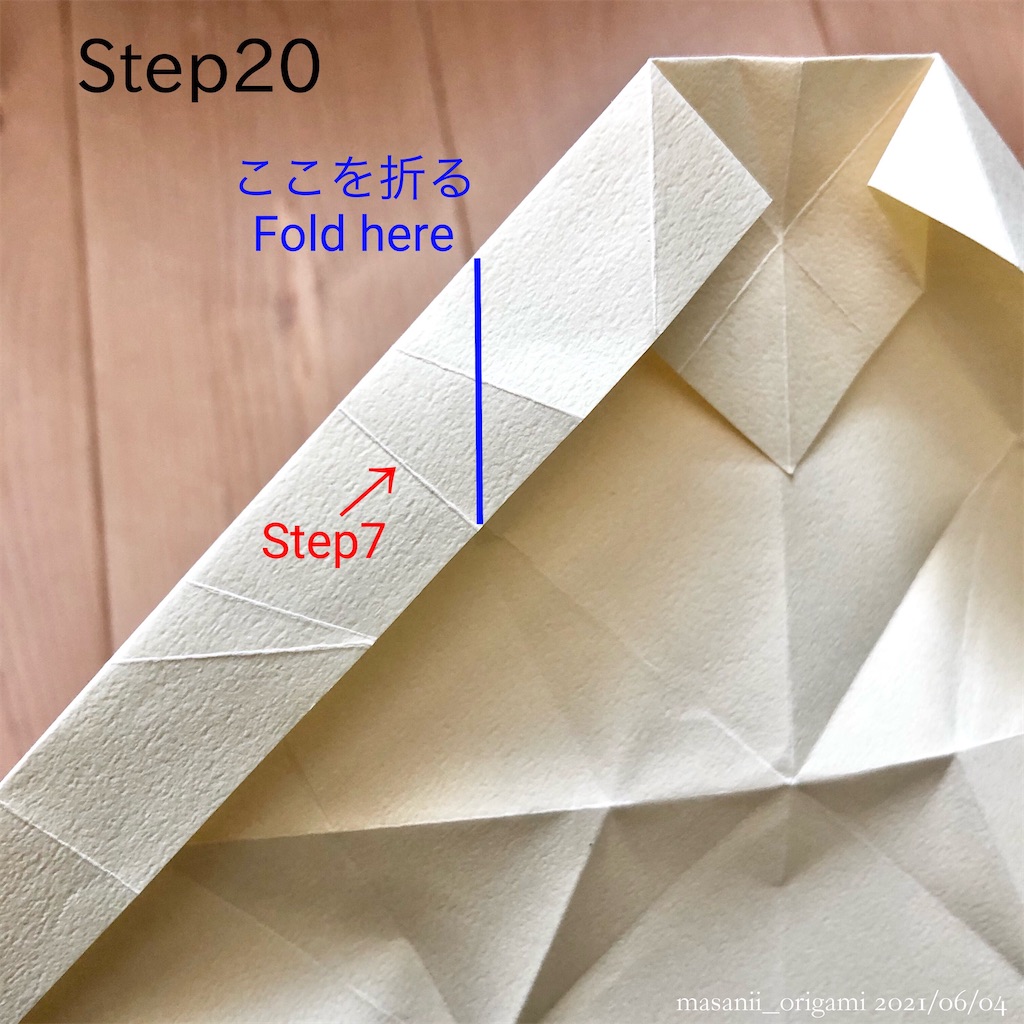
■Step20
I got an inquiry about this part.
Lower end of Step20's crease corresponds to "Upper end of Step7's crease". It's also "Upper end of Step11's crease".
In fact, this part will be "cheeks" at Step93.
There, this corresponds to red line (mountain fold).
■工程21
上端は、先程の工程20の根本にあたります。
下端は、工程8のヨコ線を基準に見ましょう。工程5のナナメ線との交点が下端です。
これを折ると「ひし形が2つ」できます。
やった人なら、この意味が分かるはず。

■Step21
Upper end corresponds to the root of Step20's crease.
To Find Lower end, you should watch Step8's horizontal crease.
Lower end corresponds to Step5's crease and its intersection.
Folding this part, two rhombus will appear.
If you can fold correctly, you'll understand what it means.
■工程22
まず、下端の「⌒⌒」を見てみましょう。
コレの正体は、工程21の線です。
この中点が工程22の下端となるので、両端から折って、中点に印をつけておきましょう。
上端になるのは、工程7と工程15の交点です。
「つまむように折る」がやりづらい場合は、テーブルの縁を押し付けるように折るのがオススメです。
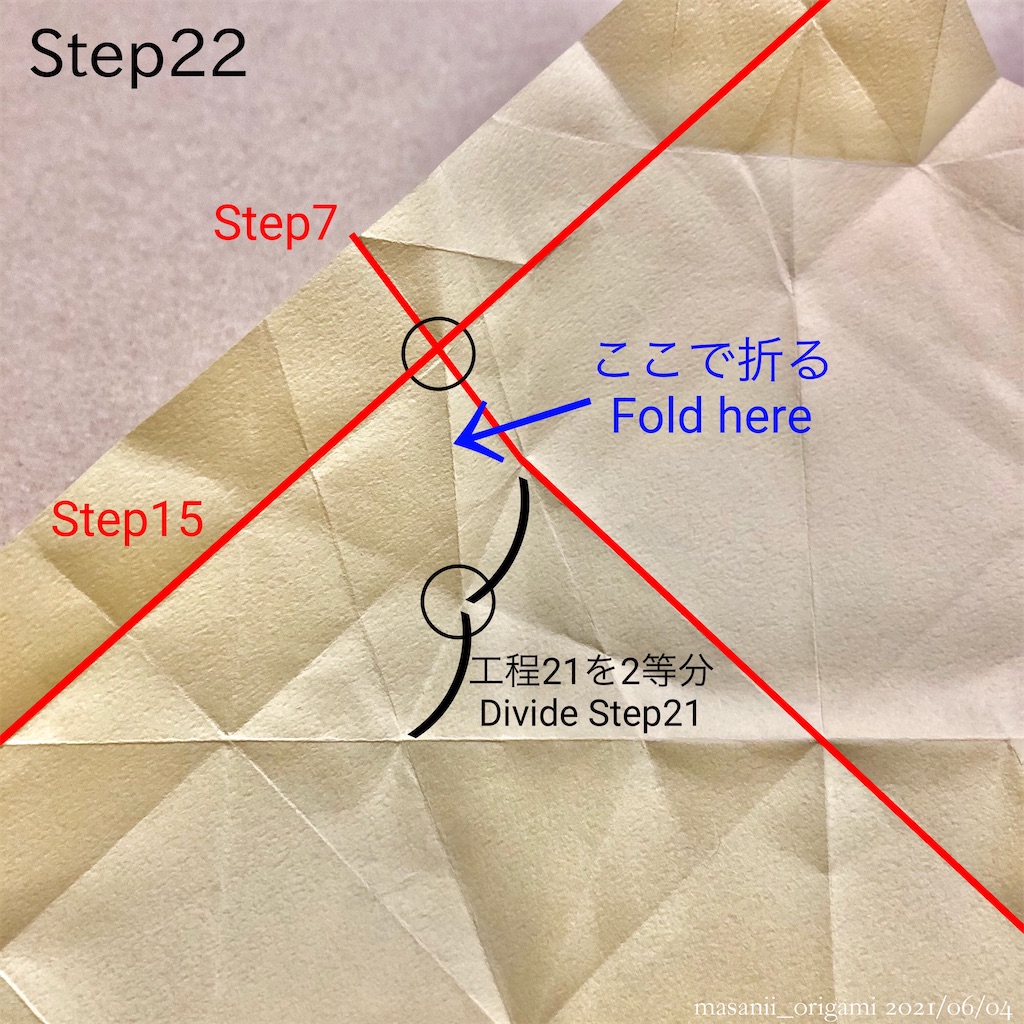
■Step22
First, look at the symbol "⌒⌒"
It's Step21's crease.
That is, the midpoint of Step21's crease will be Lower end of this part. So you should mark the midpoint by folding.
Upper end corresponds to the intersection of Step17's crease and Step15's crease.
If you feel difficult to fold like pinching, it's easy to press the paper against table.
■工程23
根本(下端)は、工程8のヨコ線と工程6のタテ線の交点。
工程6の線と工程11の線を合わせて、根本の角を2等分しましょう。
折る終点(上端)は、工程15のラインです。
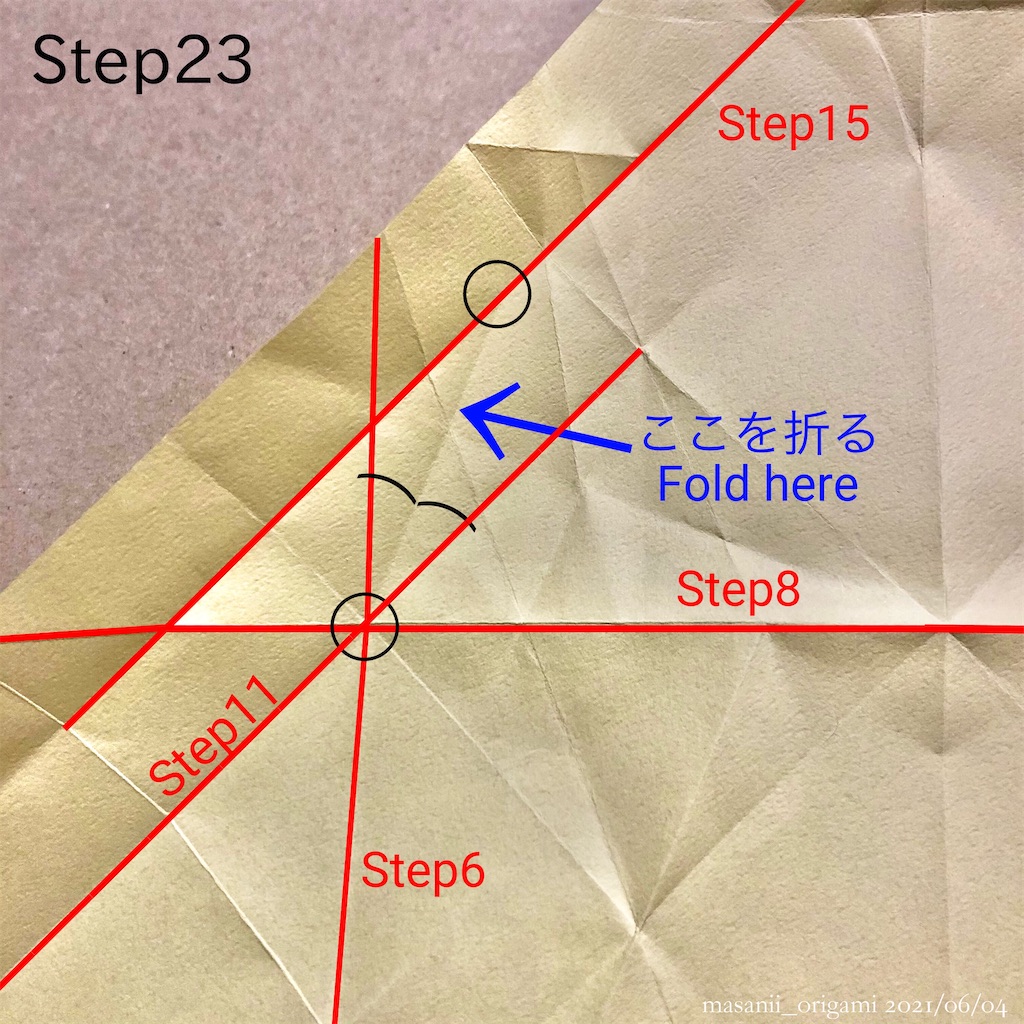
■Step23
Lower end corresponds to the intersection of Step8's horizontal crease and Step6's vertical crease.
Divide the root angle into two same angles, by matching Step6's crease and Step11's crease.
The end point to fold (Upper end) corresponds to Step15's crease.
■工程24
工程23で折った線の終点(上端)に注目です。
ここから、工程15のラインを軸に、対称になるように折ります。
線の終点(下端)は、紙のフチで工程12の端と繋がるはずです。二等辺三角形ができましたか?
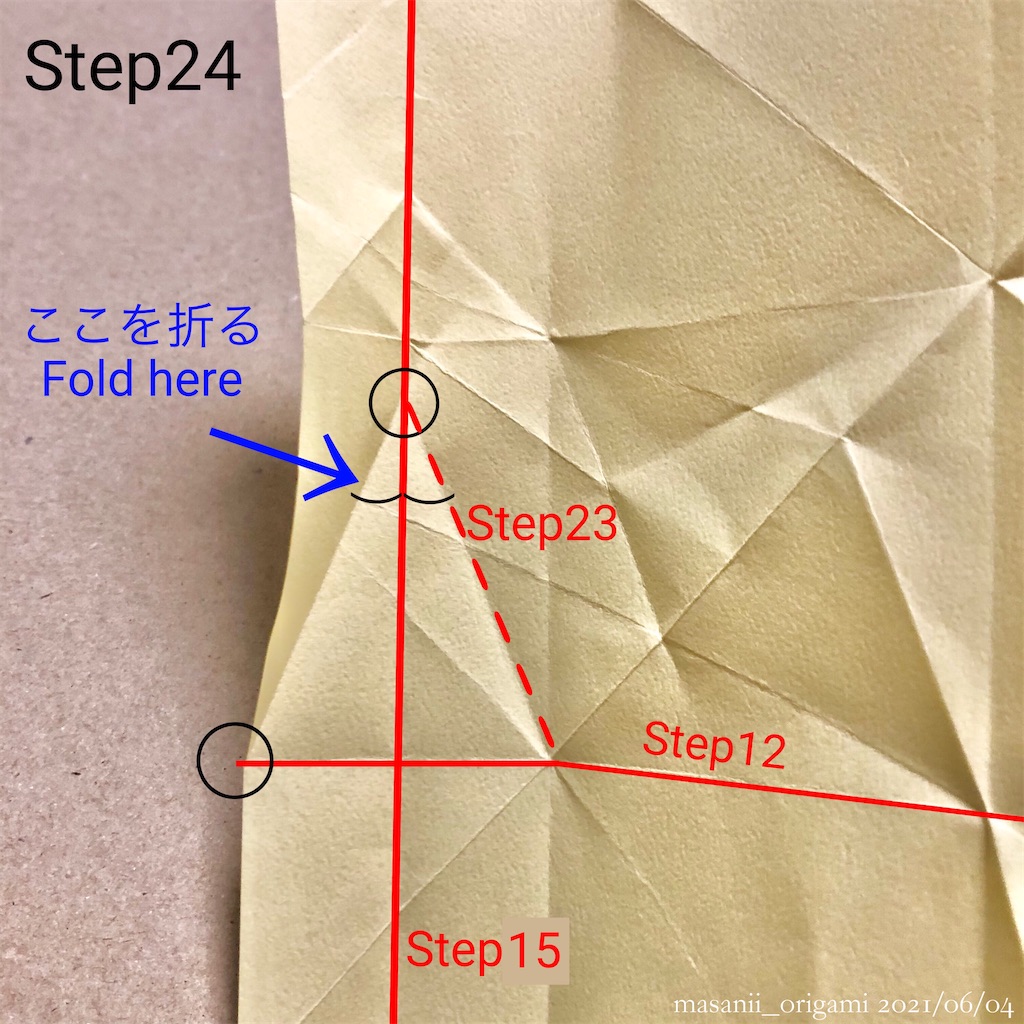
■Step24
Notice the end of Step23's crease (Upper end).
From this point, fold to be symmetrical around Step15's crease.
The end point to fold (Lower end) must connect with "Step12's end" on paper edge.
Can you see an isosceles triangle?
■工程30
下端の◯は、工程11と工程2との交点です。
上端は、工程4と工程15の交点。
テキストでは、15の線の長さが間違っている(=線の長さが足りない、前述15参照)ので、4の線とぶつかるまで延長させましょう。ここが上端となります。
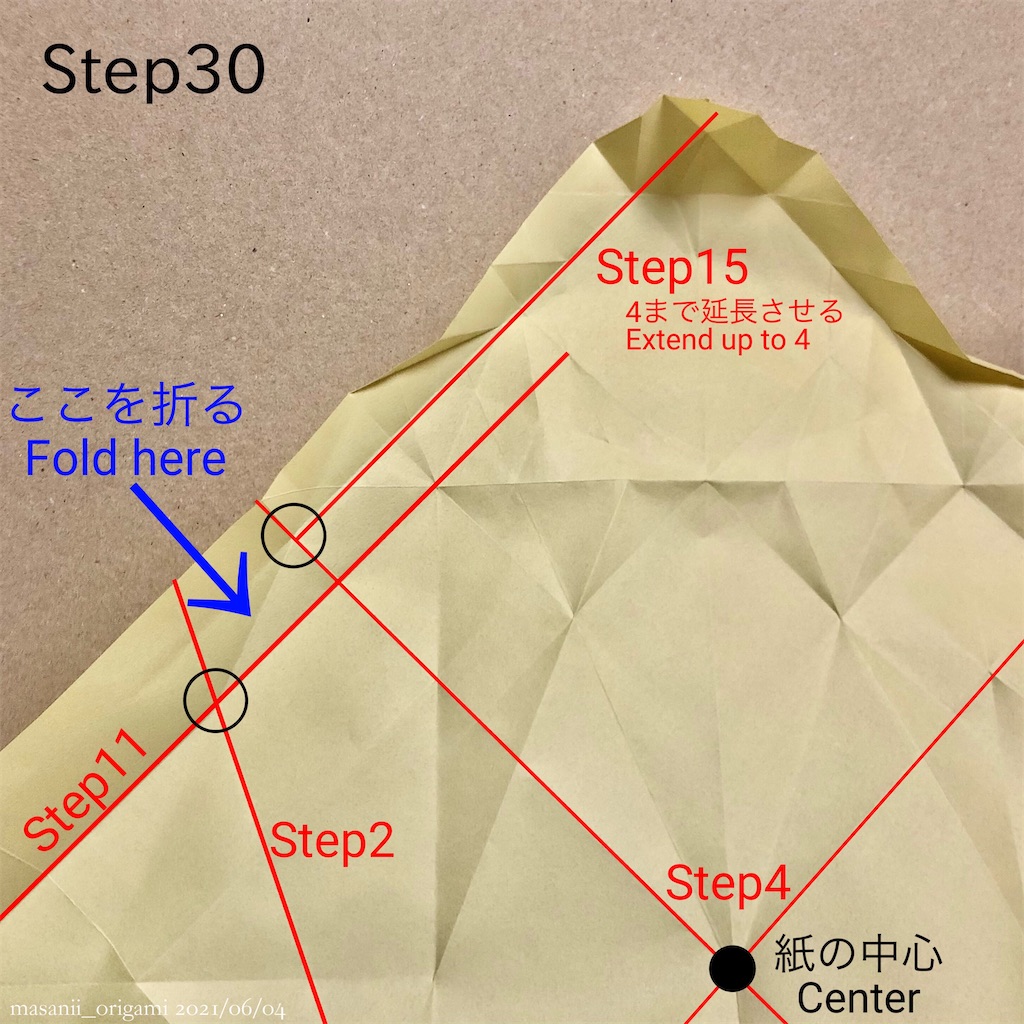
■Step30
◯ on Lower end, corresponds to the intersection of Step11's crease and Step2's crease.
Upper end corresponds to the intersection of Step4's crease and Step15's crease.
In textbook, the length of Step15's crease is wrong (=not long enough, read 15 above), so you should extend it up to Step4's crease.
This end point will be "Upper end".
■工程37
折る根本は、下の線(工程4)のライン上にある、14のナナメ線との交点。
折る角度は、「根本(下の線)から直角」が正解です。
展開したときに、中央のラインが直線になればOK。中心に「ダイヤモンド」が見えます。
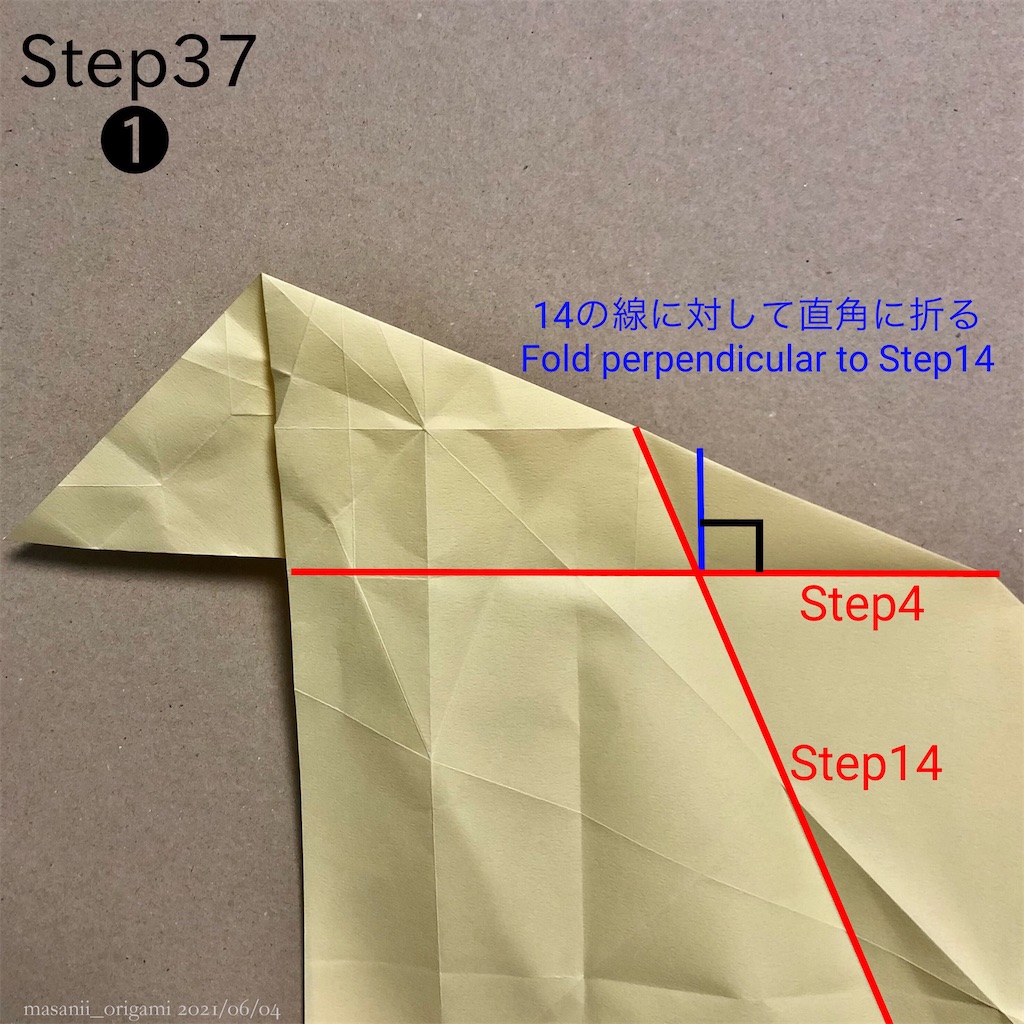


■Step37
The root to fold is the intersection of Step14's crease and the bottom line (Step4's crease).
The angle to fold is "perpendicular (=90°) to the bottom line".
It's OK if the center crease is straight when you open the entire paper.
You can see "a diamond" in the center.
■工程38
こちらは、根本から22.5°で折るのが正解です。
具体的には、
・37でつけた線の上側と、紙の中心(中割り折りの根本)の中点をつける
・37でつけた線の根本と、前述の中点を結ぶ線で折る
展開した時に「もみじ」が見えればOKです。
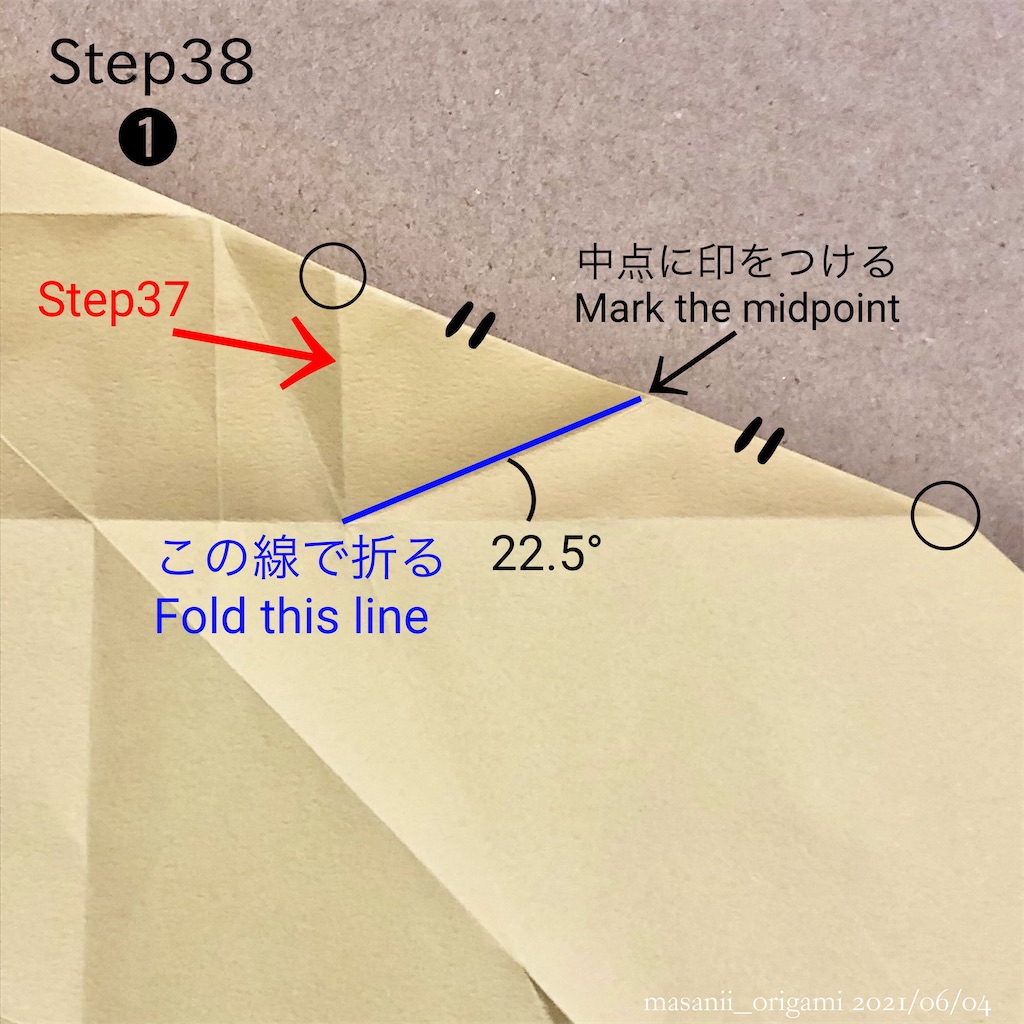
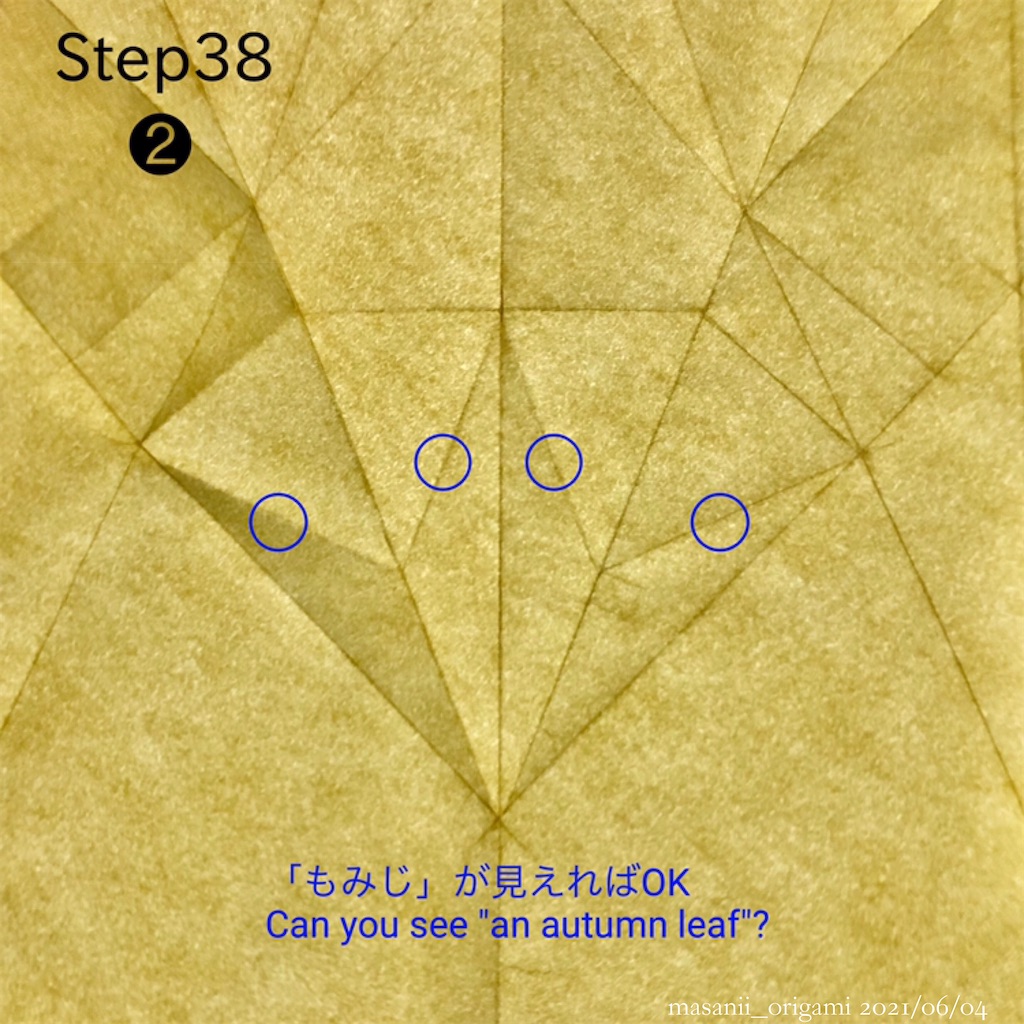
■Step38
In this part, you should fold 22.5° from the bottom line.
In particular,
・Mark the midpoint between "Upper end of Step37's crease" and "center of paper (=the root of inside reverse fold)".
・Fold along the line connecting "the root of Step37's crease" and "the point I mentioned earlier".
It's OK if you can see "an autumn leaf" when you open the entire paper.
☘️☘️☘️
はい、今日はここまで!
無事に乗り切れましたでしょうか?
この後の組み立てもなかなか大変ですが、解説記事を書くには至らず。
解説するほど分析できていないのが、正直なところです。
(果たして、あのプロセスを言語化できるのでしょうか!?)
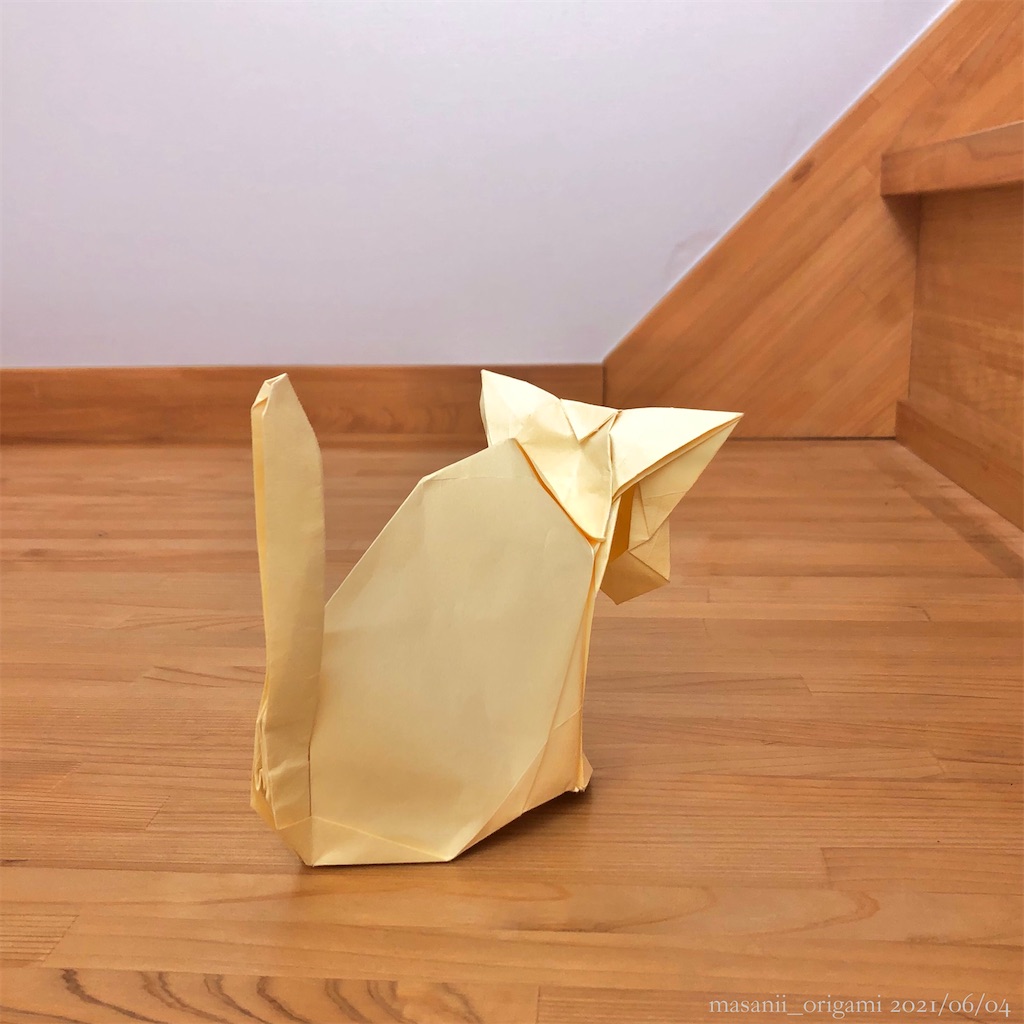
That's all for today!
Did you clear them without any problems?
After these processes, we have to assemble it, but I don't have enough skill to make an article about it yet.
My analysis has not progressed enough to explain the diagram.
(Will anyone challenge to do?)
作れば作るほどキレイになりそうな予感がするので、今後も研究を重ねていきたいと思います。
皆さんも、何か工夫しているポイントがあれば、お寄せいただけると嬉しいです。
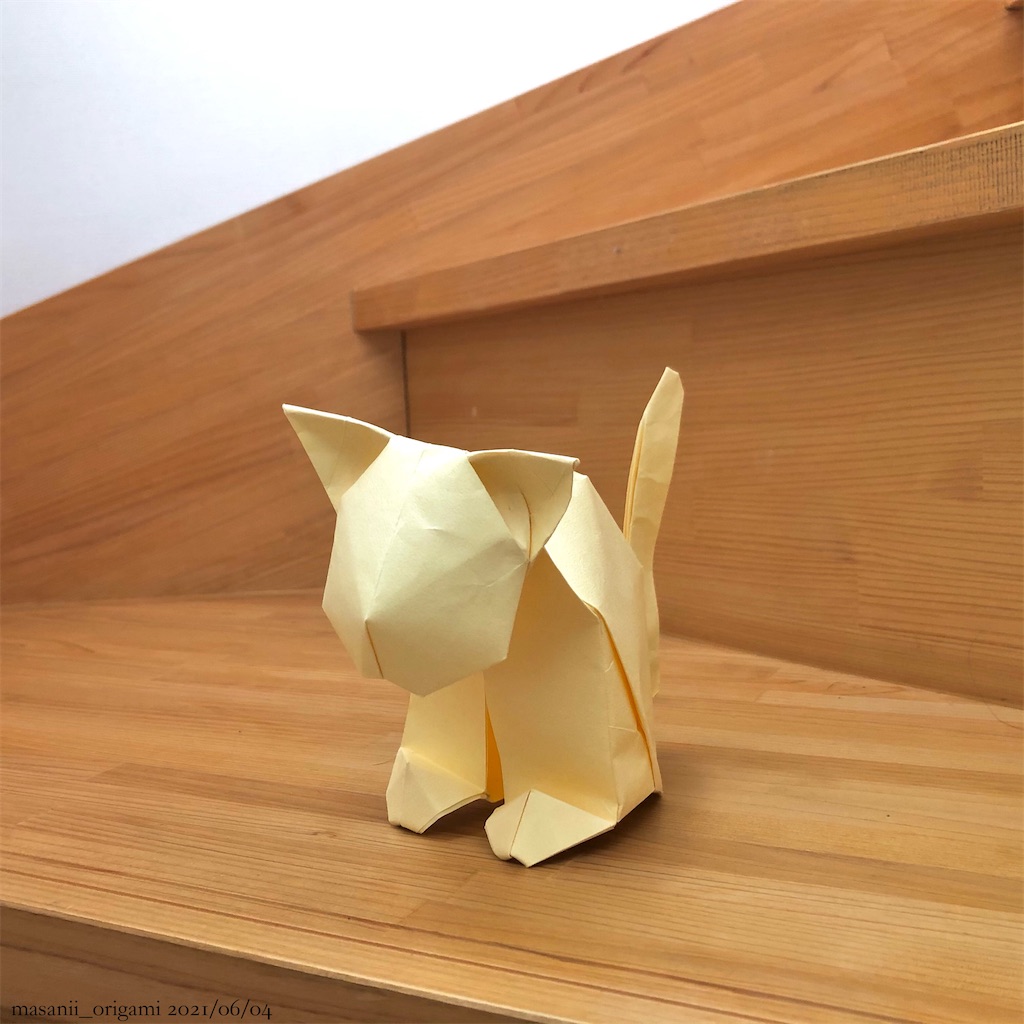
I'm sure that I improve with each trial, so I'll continue to study from now on.
I'm happy if you share any ideas.
この記事を書くにあたり、有澤悠河さんご本人に申し入れをしたのですが、掲載確認だけのつもりが、助言までいただいてしまいました。
特に工程37・38に関しては、構造から角度まで細かく教えてくださり、感謝しきりです。
(KADOKAWAさんの正誤表を教えてくれたのも有澤さんです。)
いただいた貴重な情報は、本記事に惜しみなく盛り込み、皆さんにシェアさせていただきました。
末筆ながら、この場をお借りして御礼申し上げます。
この素晴らしい作品が、より多くの人に親しまれることを願っております。
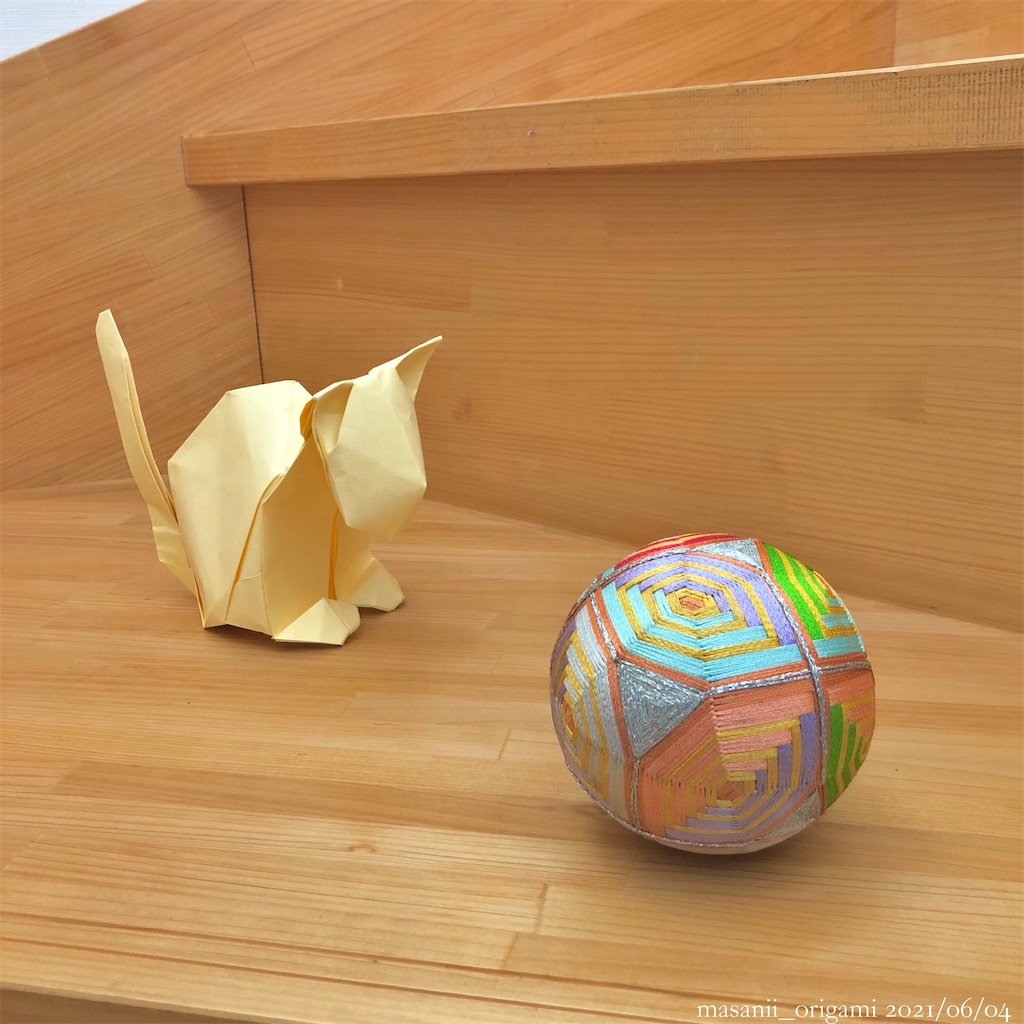
In writing this article, I confirmed with Mr. Arisawa. However, he not only accepted to write an article, but also gave me some advices!
Especially regarding Step37 & 38, he thankfully showed me details about their structures and angles.
(He also told me the errata of textbook.)
I have shared this article generously incorporating his valuable information.
I'd like to express my special thanks to him again.
I hope this wonderful model will be familiar to many fans.
それでは、アトリエまさにぃで、またお会いしましょう。
See you again in Atelier masanii:)